|
 Cranial
Deformation: Cranial
Deformation:
 The recent
discovery of the skull (right), from Sonora, Mexico has promoted a wave of articles
proclaiming it, and other similar examples to be evidence of ancient
alien contact. Images of elongated skulls or 'cone-heads' can be
seen as far back as Sumerian and Egyptian times, but the act of
cranial deformation can be traced as even further to 45,000 years
ago (1),
suggesting it's importance surpassed the safety of the child
even then as
cranial deformation is invariably carried out on infants while
the bones are supple and flexible and can be fatal in cases of excessive deformation, which raises
the important question: What was it that has led so many people
from so many varied cultures to incorporate this
characteristic into their children.? The recent
discovery of the skull (right), from Sonora, Mexico has promoted a wave of articles
proclaiming it, and other similar examples to be evidence of ancient
alien contact. Images of elongated skulls or 'cone-heads' can be
seen as far back as Sumerian and Egyptian times, but the act of
cranial deformation can be traced as even further to 45,000 years
ago (1),
suggesting it's importance surpassed the safety of the child
even then as
cranial deformation is invariably carried out on infants while
the bones are supple and flexible and can be fatal in cases of excessive deformation, which raises
the important question: What was it that has led so many people
from so many varied cultures to incorporate this
characteristic into their children.?
'Cranial deformation can be defined as the
product of �dynamic distortion of the normal vectors of the
infantile neurocranial growth through the agency of
externally applied forces' (Moss, 1958; p 275). It has been
found in every continent and is not limited to humans
(Shapiro, 1927; Trinkaus, 1982; Gerszten and Gerszten, 1995;
Tubbs, Salter, and Oaks, 2006).
(5)
As noted above, the cultural preference for
elongated skulls has found its way onto every continent on the
earth suggesting a cultural connection of great antiquity, and
therefore one of potential importance. In the earliest Sumerian
Al Ubiad pottery, there is a clear association to the gods, and
variations on the idea that it was a symbol of status, high
rank, or wisdom have been recorded in the traditions of
differing cultures around the world offering a common theme that
exists in the minds of people to this day. The
pertinent question with regard this phenomena is whether or not
such cranial deformity
dolichocephaly
has
ever existed naturally in humans, and if so, what is the
significance of such persistent emulation through artificial
deformity by so many peoples for such a long time.
The earliest known examples of intentional human cranial deformation predate
written history and date back to 45,000 BC in
Neanderthal skulls, and to the Proto-Neolithic Homo sapiens component (12th
millennium BCE) from
Shanidar Cave in
Iraq. It also occurred among Neolithic peoples in SW Asia.
(1)
and even greater antiquity has been assigned to dolicho-anomalies at
Neolithic-Cyprus, Kow Swamp, Australia (13,000 BP), "and perhaps 18,000 - 23,000 BP.
at Chou Kou Tien, China." (7)
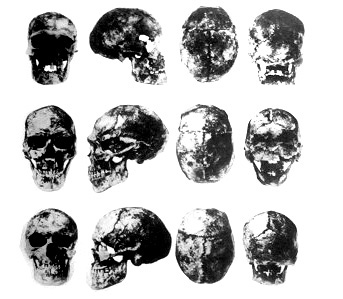
Examples of
Dolicocephalic Czech Cranium 35,000 BC:
The earliest written record of cranial deformation dates to
400 BC in
Hippocrates' description of the
Macrocephali or Long-heads, who were named for their
practice of cranial modification. He said of it:
"14. I will pass over the smaller
differences among the nations, but will now treat of such as
are great either from nature, or custom; and, first,
concerning the Macrocephali [tribe or `nation'
said to be living beyond the Bosphorus / Black Sea or maybe
even further i.e
Scythians - RD] There is no other race of men
which have heads in the least resembling theirs".
"...At first, usage was the principal cause of the length of
their head, but now nature cooperates with usage. They think
those the most noble who have the longest heads...".
"It is thus with regard to the usage: immediately after the
child is born, and while its head is still tender, they
fashion it with their hands, and constrain it to assume a
lengthened shape by applying bandages and other suitable
contrivances whereby the spherical form of the head is
destroyed, and it is made to increase in
length". -
The act of artificial
cranial deformation on infants was present in numerous ancient cultures,
including some of the greatest, such as the Indus Valley, Sumerian,
Egyptian, Olmec, Mayan, Inca etc etc... At present, such practices are all
but gone but they were recorded into the 20th century with records of 'Some isolated groups in Africa and
South America who continue this practice'.
(3) Of
particular interest are those peoples which have been recorded to show a
'natural' or genetically inherited tendency for elongated skulls, as it has
been shown that the biological result of such deformation is a larger skull,
but perhaps more significantly, a larger brain. Something which offers a
clear incentive for such potentially dangerous practices on newborns, but
also one which takes on a different light in consideration of the persistent
veneration for elongated heads.
|
Geographical Distribution: |
It has been
mentioned that skull elongation was present all around the ancient
world, appearing in several different and apparently unrelated
cultures. The following examples offer a basic representative
description of the similarities and differences in the practices of
skull deformation between these cultures. The basic procedure of
moulding the skull was carried out on infants as their cranium is
soft and pliable while they are in their early years. It involved
attaching a plank of padding to the front of the skull and
compressing it into the desirable shape. It will be seen that there
is a suggestion that elongated skulls may have been a genetically
inherited trait in some cases, while the majority of known examples
are demonstrated to be an emulation of this.
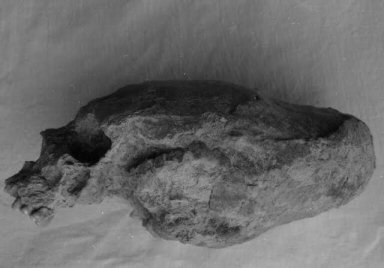 Early-Neolithic
deformed skull from Iran, Wikipedia image: these skulls are common
from about 5,000 to 7,000 BC in the areas that would later become
Iran and then diffusing out into the surrounding territories. Many
skulls in the same time period from Iraq, Southern Turkey and Syria
are also deformed but not usually so severely. In later historical
time many of the Iranian-speaking nomads of Central Asia continued
the tradition and eventually the trait was introduced into Europe
from the East by the invasions of the Huns.
(8) Early-Neolithic
deformed skull from Iran, Wikipedia image: these skulls are common
from about 5,000 to 7,000 BC in the areas that would later become
Iran and then diffusing out into the surrounding territories. Many
skulls in the same time period from Iraq, Southern Turkey and Syria
are also deformed but not usually so severely. In later historical
time many of the Iranian-speaking nomads of Central Asia continued
the tradition and eventually the trait was introduced into Europe
from the East by the invasions of the Huns.
(8)
In the
Old world,
'Huns' and 'Alans' are also known to have practised similar cranial
deformation. At around AD 300-600, the
East Germanic tribes who were ruled by the Huns, adopted this
custom.

The Sumerians:
The earliest significant record of skull elongation comes in the
form of the pottery representations of the Gods
from the 5th millennium B.C. The
Al-Ubaid culture proceeded the Sumerian culture was a people
known as the Ubaidians who established settlements in the region
later known as Sumer (Mesopotamia)
(2) It has
been noticed that there
are very strong similarities between the Ubaid artwork, and that
of of 'Old Europe' Vinca Culture
which flourished c. 6,000 - 3,500 BC.
John Marshall�s �Mohenjo-Daro
and the Indus Civilization� as well as �Anthropology�
(by Ram Nath Sharma, Rajendra Kumar Sharma) in addition to Al-Ubaid
burials, wrote that cranial deformation features were also seen of
skulls of Kish; Ur of Mesopotamia; Additanallur in Madras; Veddahs
of Ceylon (Sri Lanka); Naga of Calcutta; jar burials of Harappa;
Mediterranean; Nal in Baluchistan; Sialkot in Punjab; and Bayana
(Aryan skulls) in Uttar Pradesh.
(2)
Marshall (9)
makes a comparison between the elongated Al Ubaid
skulls and those found from the Indus Valley Civilisation, noting
that the Al Ubaid skulls are 'Not as elongated as those from
Mohenjo-Daro'.
(More abut the Sumerians)
In Egypt, evidence of elongated skulls appears in
all the members of the royal family in during the Armana epoch,
including King Akhenaten. Queen Nefertiti, their six
female children and Tutankamun. (Busts have been found of two of the
daughters and they both have elongated heads. (4)
The Skulls of
Rameses II, several centuries later also show elongation
of the skull
(below), and that of his (suspected) first son Amun-her-khepeshef seem eerily similar to those of
the two earlier Pharaohs.
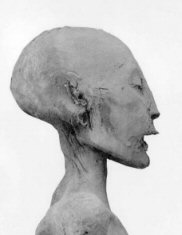 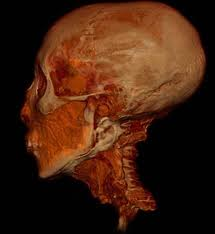

From left to
right: The skulls of Nefertiti, Tutankhamen, and Rameses II.
Whether or not this was a genetic trait or one
enforced on the royal members at birth is unknown, but while the
cranium appear extended at the rear, they do not show any evidence
of artificial deformation. Perhaps relevant that In the 1st Century,
Egyptian priest-scribes, then keepers of the world's oldest known
records, claimed that the earliest rulers of Egypt were non-humans
:- immortals. "Mortals have been Kings of their country, they
say, for a little less than 5,000 years" - from Diodorus (Wiki
ref), which is the same belief ascribed by the earliest
Sumerians, who depicted their gods as having elongated heads.
 Pre-Columbian
Americas: In the Americas the
Maya,
Inca, and certain tribes of
North American Indians performed
the custom. (1)
The earliest examples of elongated skulls comes in the form of Olmec
art. The jade figurines (Right) were found at La Venta buried
beneath the floor of a temple courtyard c. 1,000 BC.
Evidently, some unknown time after the initial burial, the site was
opened again through the courtyard floor (clearly, someone knew
exactly where the burial was located) and excavated to the level of
the heads of the buried figurines. After this "inspection", the
offering was covered up again and never opened again until recent
time. Pre-Columbian
Americas: In the Americas the
Maya,
Inca, and certain tribes of
North American Indians performed
the custom. (1)
The earliest examples of elongated skulls comes in the form of Olmec
art. The jade figurines (Right) were found at La Venta buried
beneath the floor of a temple courtyard c. 1,000 BC.
Evidently, some unknown time after the initial burial, the site was
opened again through the courtyard floor (clearly, someone knew
exactly where the burial was located) and excavated to the level of
the heads of the buried figurines. After this "inspection", the
offering was covered up again and never opened again until recent
time.
(More
about La Venta)
 The Paracas Culture (c. 700 BC - 100 AD): One
intriguing aspect of this culture which has been overlooked by most
researchers is the fact that the nobility practiced skull binding,
resulting in cranial deformation.
The Paracas situation is somewhat unique in that researchers Juan
Navarro and Brien Foerster have found the presence of at least 5
distinct shapes of elongated skulls, each being predominant in
specific cemeteries. The largest and most striking are from a site
called Chongos, near the town of Pisco, north of Paracas. These
skulls are called "cone heads" by many who see them, because of
their literal conical appearance. Testing of these have illustrated
that, on average, the cranial capacity is 1.5 Ltr's, approximately
25% larger than contemporary skulls, and weigh as much as 60 percent
more. Also, eye orbit cavities are significantly larger than
contemporary skulls, and the jaws are both larger and thicker.
(1) The Paracas Culture (c. 700 BC - 100 AD): One
intriguing aspect of this culture which has been overlooked by most
researchers is the fact that the nobility practiced skull binding,
resulting in cranial deformation.
The Paracas situation is somewhat unique in that researchers Juan
Navarro and Brien Foerster have found the presence of at least 5
distinct shapes of elongated skulls, each being predominant in
specific cemeteries. The largest and most striking are from a site
called Chongos, near the town of Pisco, north of Paracas. These
skulls are called "cone heads" by many who see them, because of
their literal conical appearance. Testing of these have illustrated
that, on average, the cranial capacity is 1.5 Ltr's, approximately
25% larger than contemporary skulls, and weigh as much as 60 percent
more. Also, eye orbit cavities are significantly larger than
contemporary skulls, and the jaws are both larger and thicker.
(1)
Three pre-Incan
"nations or races" were determined through skull morphology by Dr. Tschudi (6).
He names the Chinchas, Aymaraes, and Huancas. He suggested that
Skulls of the Chinchas were what we would call normally human. The
other two "races" were remarkably unlike the Chinchas. The Huancas
had the most pronounced dolichocephalic traits. And it was this
people about which Tschudi had the least amount of historical data.
The Aymaraes "commenced the dynasty of the Incas." Of the Aymaraes,
Tschudi said, "The crania of these people present differences
equally remarkable ... and particularly the contour of the cranium."
Keeping in mind that Inca is a term venerating the emperors of Peru,
not a tribe/nation per s� - He proposed that the Aymaraes conquered
the other two peoples and marshaled the unity of Inca civilization
It is interesting to note that of the three "races" discussed, the
non-dolicho-headed group, the Chinchas, artificially mimed the
actual "conehead" peoples.
|
The Mysterious Disappearance of the Maltese
Skulls.
It was public knowledge that until 1985 a number of skulls,
found in pre-historic Maltese temples at Taxien, Ggantja and Hal
Saflienti, were exposed in the Archaeological Museum in Valletta.
They have since disappeared without a trace.
 'Only the photographs taken by the Maltese
researcher Dr. Anton Mifsud and his colleague, Dr. Charles Savona
Ventura, remain to testify the existence of the skulls and
prove their abnormality. Books written by the two Maltese doctors,
illustrate a collection of skulls
that show peculiar abnormalities and/or pathologies. Sometimes
inexistent cranial knitting lines, abnormally developed temporal
partitions, drilled and swollen occiputs as following recovered
traumas, but above all, a strange, lengthened skull, bigger and more
peculiar than the others, lacking of the median knitting. The
presence of this finding leads to a number of possible hypotheses in
consideration of other finds of similar skulls, from Egypt to South
America, the particular deformity, unique in the panorama of medical
pathology referred to such distant times, (we are talking about
approximately 3000 BC) could be an exceptional discovery. 'Only the photographs taken by the Maltese
researcher Dr. Anton Mifsud and his colleague, Dr. Charles Savona
Ventura, remain to testify the existence of the skulls and
prove their abnormality. Books written by the two Maltese doctors,
illustrate a collection of skulls
that show peculiar abnormalities and/or pathologies. Sometimes
inexistent cranial knitting lines, abnormally developed temporal
partitions, drilled and swollen occiputs as following recovered
traumas, but above all, a strange, lengthened skull, bigger and more
peculiar than the others, lacking of the median knitting. The
presence of this finding leads to a number of possible hypotheses in
consideration of other finds of similar skulls, from Egypt to South
America, the particular deformity, unique in the panorama of medical
pathology referred to such distant times, (we are talking about
approximately 3000 BC) could be an exceptional discovery.
The skulls were all found in the Hal Saflienti
hypogeum, where a sacred well was dedicated to the Mother Goddess
and where also the small statue of a sleeping goddess was found,
associated to a relic with a snake inscription on it. One in
particular had a cranium showing a
very pronounced dolichocephalous, in other words, a lengthened
posterior part of the skullcap, besides the lack of median knitting,
technically named "sagitta". This last detail has been
considered "impossible" by medics and anatomists, not having
analogous pathological cases in international medical literature. It
is a characteristic that emphasizes the anomaly of this finding with
the result of producing a natural lengthening of the cranium (not
due to bandaging or boards as used in pre-Colombian civilizations)'.
It is proposed, on the basis of these findings,
that the group of skulls found in the Hypogeum were representative
of a group of peoples who were considered of importance (as attested
to by the location of their discovery), and who had a natural
genetic tendency for elongated skulls, were integrally involved in
the activities of the temple builders of the time. Other skulls
found in the
Brochtorff
circle (Hypogeum II), are considered to have had
their heads bandaged in order to produce their cranial deformities.
(Extract from Hera Magazine, Italy: 1999)
From
NATIONAL GEOGRAPHIC MAGAZINE January to June, 1920 VOLUME XXXVII
"From an examination of the skeletons of the polished-stone age,
it appears that the early inhabitants of Malta were a race of
long-skulled people of lower medium height, akin to the early people
of Egypt, who spread westward along the north coast of Africa,
whence some went to Malta and Sicily and others to Sardinia and
Spain."
(More
about Prehistoric Malta)
|
Friedrich Ratzel in
'The History of Mankind'
reported in 1896 that deformation of the skull, both by flattening
it behind and elongating it towards the vertex, was found in
isolated instances in
Tahiti, Samoa, Hawaii,
and the Paumoto group and occurring most frequently on Mallicollo in the
New Hebrides (today
Malakula,
Vanuatu), where the skull was squeezed extraordinarily flat. The practice was also known among the
Australian Aborigines.
In trying to understand the motivation behind such a persistent cultural
manifestation, it is worth remembering both that it it is potentially lethal
process for the infants, at the same that it appears present in
almost every culture in the prehistoric world. Whatever its origin, the idea that it was a beneficial
practice held true in people around the world right up to the turn of the
twentieth century. The extreme antiquity of the tradition is shown by
archaeology yet as it stands today, it exists without a rational biological or
evolutionary beneficial explanation and we are left to the conclusion that it
was primarily a 'cosmetic' feature.
However, there is a
fundamental difference between cranial deformation and other
cultural forms of
bodily mutilation (such as foot bandaging, genitalia deformation, scarring or
tattooing), because
the literature invariably concludes that such cranial deformation was intended
to emulate either the look of the gods, the nobility, or to demonstrate social status.
'Even in the remote
Nahai-speaking area of
Tomman Island and the south south-western
Malakulan (Australasia), a person with an elongated head is
thought to be more intelligent, of higher
status, and closer to the world of the spirits' (1).
Hippocrates (from 400 BC) tells us that the
practice among the Scythians was for
the purpose of giving a certain
aristocratic distinction.
Amed�e Thierry, in his
�History of Attila,� says the Huns used it
for the same reason;
(2)
'The following heads.. (from Del Rio�s
�Account of Palenque,� copied into Nott and Gliddon�s �Types of
Mankind,� p. 440) ...show that the receding forehead was a natural
characteristic of the ancient people of Central America. The same
form of head has been found even in fossil skulls. We may therefore
conclude that the skull-flattening, which we find to have been
practised in both the Old and New Worlds, was an attempt of other
races to imitate the form of skull of a people whose likenesses are
found on the monuments of Egypt and of America. It has been shown
that this peculiar form of the head was present even in the f�tus of
the Peruvian mummies'. (2)
"The Maya elite practised changing the shape
of their offsprings' skulls to resemble the Maize God's
elongated head by tying two boards front and back against the
infant's head" from `Civilization.CA'
This intrinsic
difference separates cranial deformation from other physical
deformation activities as there is evidence that there may be
a biological benefit from the process... Something which the
academic establishment has yet to explore, but the evidence from
recent research suggests that skull elongation results in both a larger
cranium, and a larger brain (1):
surely a relevant finding in the light of the association with
elongated skulls and the idea that the process makes a person
'more intelligent, of higher
status, and closer to the world of the spirits'..?
Nature Vs Nurture:
Hippocrates was the first person to suggest the
idea that cranial elongation might be an inherited factor. Somewhat
remarkably, he specifically recorded the fact when he said:
'At first, usage was the principal cause of the length of
their head, but now nature cooperates with usage'.
As seen in the case of the Paracas culture
(above),
it has been suggested that certain examples
of elongated skulls which have been found
around the world are neither the result of
congenital deformation (birth defects), or
inflicted deformity (cranial binding),
leaving the alternative of an
inherited genotype. Something which doesn't sit
well with certain anthropologists. Of
course, without a proper DNA testing program, it
remains impossible to determine which skulls were the
result of artificial deformation and which, if any, were
a natural genetic trait (such as hair, eye colour etc).
The lack of credible testing in this area (and the
disappearance of the Maltese skulls) has greatly
contributed to the current level of misunderstanding in
this area of study.
There are
always cases of exception in the medical
record, but of particular interest here is
the fact that the volume of some of these skulls has
been found to be twice that of a normal
skull, and with it an increased brain
capacity, which raises the obvious question:
How is it possible for the skull and brain
capacity to increase in a human unless it is
caused by genotype, and what is the effect
on the individual.?
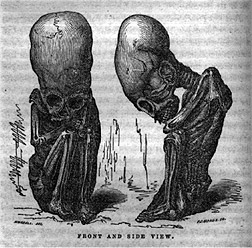 Dr. Tschudi offers, "...physiologists
are undoubtedly in error, who suppose (dolichocephaly in) the
Peruvian race is exclusively artificial. This hypothesis rests on
insufficient grounds; its authors could have made their observations
solely on the crania of adult(s) ... (however) two mummies of
children (analyzed in England) ... belonged to the tribe Aymaraes.
The two crania (both of children scarce a year old), had in all
respects, the same form as those of adults. We ourselves have
observed the same fact in many mummies of children of tender age..." Dr. Tschudi offers, "...physiologists
are undoubtedly in error, who suppose (dolichocephaly in) the
Peruvian race is exclusively artificial. This hypothesis rests on
insufficient grounds; its authors could have made their observations
solely on the crania of adult(s) ... (however) two mummies of
children (analyzed in England) ... belonged to the tribe Aymaraes.
The two crania (both of children scarce a year old), had in all
respects, the same form as those of adults. We ourselves have
observed the same fact in many mummies of children of tender age..."
"More still: the same
formation of the head presents itself in children yet unborn; and of this truth
we have had convincing proof in sight of a foetus enclosed in the womb of a
mummy of a pregnant woman, ... which is, at this moment, in our collection."
The foetus was aged 7 months! (6)
The records of the
inspections of the Maltese skulls also suggest that
there were elongated skulls present that weren't artificially modified, but were a natural feature (a genetic
aberration, or an inherited one). The recognition that larger skulls
also have a larger brain capacity certainly provides an impetus for
such practices, but doesn't answer the question of who the original
cone-heads were, or why they were emulated for so persistently
around the ancient world. Sadly, these are questions that can only
be answered through comparative DNA testing of elongated skulls
around the world, something that has yet to be done.
(Giants:
Fact or Fiction)
(Prehistoric
Cross-culturality)
(A-Z
Index)
|
 The recent
discovery of the skull (right), from Sonora, Mexico has promoted a wave of articles
proclaiming it, and other similar examples to be evidence of ancient
alien contact. Images of elongated skulls or 'cone-heads' can be
seen as far back as Sumerian and Egyptian times, but the act of
cranial deformation can be traced as even further to 45,000 years
ago (1),
suggesting it's importance surpassed the safety of the child
even then as
cranial deformation is invariably carried out on infants while
the bones are supple and flexible and can be fatal in cases of excessive deformation, which raises
the important question: What was it that has led so many people
from so many varied cultures to incorporate this
characteristic into their children.?
The recent
discovery of the skull (right), from Sonora, Mexico has promoted a wave of articles
proclaiming it, and other similar examples to be evidence of ancient
alien contact. Images of elongated skulls or 'cone-heads' can be
seen as far back as Sumerian and Egyptian times, but the act of
cranial deformation can be traced as even further to 45,000 years
ago (1),
suggesting it's importance surpassed the safety of the child
even then as
cranial deformation is invariably carried out on infants while
the bones are supple and flexible and can be fatal in cases of excessive deformation, which raises
the important question: What was it that has led so many people
from so many varied cultures to incorporate this
characteristic into their children.?
 Early-Neolithic
deformed skull from Iran, Wikipedia image: these skulls are common
from about 5,000 to 7,000 BC in the areas that would later become
Iran and then diffusing out into the surrounding territories. Many
skulls in the same time period from Iraq, Southern Turkey and Syria
are also deformed but not usually so severely. In later historical
time many of the Iranian-speaking nomads of Central Asia continued
the tradition and eventually the trait was introduced into Europe
from the East by the invasions of the Huns.
(8)
Early-Neolithic
deformed skull from Iran, Wikipedia image: these skulls are common
from about 5,000 to 7,000 BC in the areas that would later become
Iran and then diffusing out into the surrounding territories. Many
skulls in the same time period from Iraq, Southern Turkey and Syria
are also deformed but not usually so severely. In later historical
time many of the Iranian-speaking nomads of Central Asia continued
the tradition and eventually the trait was introduced into Europe
from the East by the invasions of the Huns.
(8)



 Pre-Columbian
Americas: In the Americas the
Maya,
Inca, and certain tribes of
Pre-Columbian
Americas: In the Americas the
Maya,
Inca, and certain tribes of
 The Paracas Culture (c. 700 BC - 100 AD): One
intriguing aspect of this culture which has been overlooked by most
researchers is the fact that the nobility practiced skull binding,
resulting in cranial deformation.
The Paracas situation is somewhat unique in that researchers Juan
Navarro and Brien Foerster have found the presence of at least 5
distinct shapes of elongated skulls, each being predominant in
specific cemeteries. The largest and most striking are from a site
called Chongos, near the town of Pisco, north of Paracas. These
skulls are called "cone heads" by many who see them, because of
their literal conical appearance. Testing of these have illustrated
that, on average, the cranial capacity is 1.5 Ltr's, approximately
25% larger than contemporary skulls, and weigh as much as 60 percent
more. Also, eye orbit cavities are significantly larger than
contemporary skulls, and the jaws are both larger and thicker.
(1)
The Paracas Culture (c. 700 BC - 100 AD): One
intriguing aspect of this culture which has been overlooked by most
researchers is the fact that the nobility practiced skull binding,
resulting in cranial deformation.
The Paracas situation is somewhat unique in that researchers Juan
Navarro and Brien Foerster have found the presence of at least 5
distinct shapes of elongated skulls, each being predominant in
specific cemeteries. The largest and most striking are from a site
called Chongos, near the town of Pisco, north of Paracas. These
skulls are called "cone heads" by many who see them, because of
their literal conical appearance. Testing of these have illustrated
that, on average, the cranial capacity is 1.5 Ltr's, approximately
25% larger than contemporary skulls, and weigh as much as 60 percent
more. Also, eye orbit cavities are significantly larger than
contemporary skulls, and the jaws are both larger and thicker.
(1) Dr. Tschudi offers, "...physiologists
are undoubtedly in error, who suppose (dolichocephaly in) the
Peruvian race is exclusively artificial. This hypothesis rests on
insufficient grounds; its authors could have made their observations
solely on the crania of adult(s) ... (however) two mummies of
children (analyzed in England) ... belonged to the tribe Aymaraes.
The two crania (both of children scarce a year old), had in all
respects, the same form as those of adults. We ourselves have
observed the same fact in many mummies of children of tender age..."
Dr. Tschudi offers, "...physiologists
are undoubtedly in error, who suppose (dolichocephaly in) the
Peruvian race is exclusively artificial. This hypothesis rests on
insufficient grounds; its authors could have made their observations
solely on the crania of adult(s) ... (however) two mummies of
children (analyzed in England) ... belonged to the tribe Aymaraes.
The two crania (both of children scarce a year old), had in all
respects, the same form as those of adults. We ourselves have
observed the same fact in many mummies of children of tender age..."